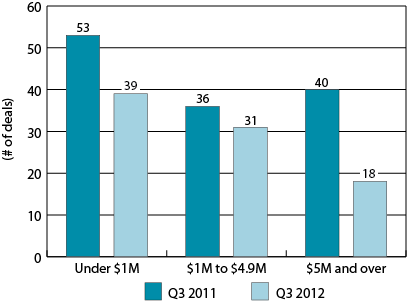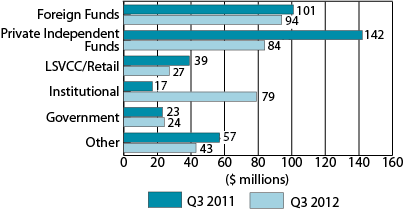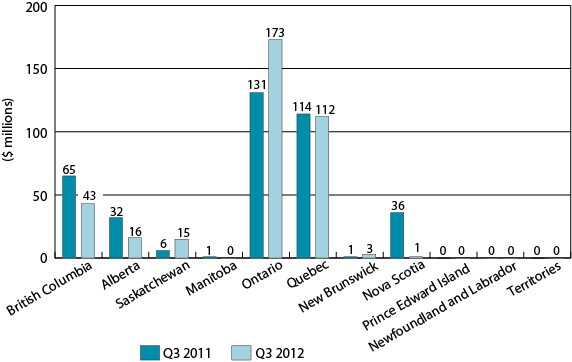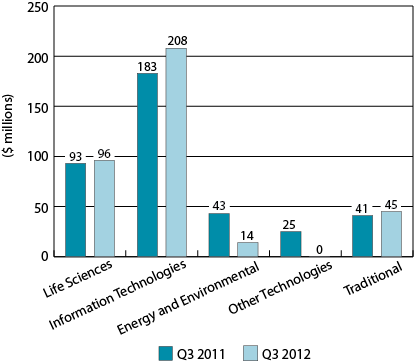PDF Version
Venture Capital Monitor - Q3 2012
1.1 MB, 6 pages
This publication by the Small Business Branch provides current information about the venture capital industry in Canada. The series will track trends in investment activity, report on topical research and look at key technology clusters where investment is taking place.
Introduction
This issue covers venture capital (VC) investment and fundraising activity in Canada during the third quarter of 2012. It also describes recent Government of Canada activity in the VC market.
VC activity overview
Investment and fundraising
Small decline in year-over-year investment levels during Q3 2012
Following a strong second quarter, the Canadian VC market experienced a slight decline over Q3 2012. As a whole, $363 million was invested into 88 companies down 6 percent from the $386 million invested into 129 companies over the same period the previous year (Table 1). Despite this, Canadian VC in 2012 remains on pace to match 2011 levels based on the strength of a strong second quarter when $444 million was invested into Canadian companies (Figure 1).
| Q3 2011 | Q3 2012 | Percent Change | |
|---|---|---|---|
| ($ millions) | |||
| Source: Thomson Reuters Canada 2012. | |||
| Investment | 385 | 363 | −6% |
| Fundraising | 365 | 42 | −89% |
Figure 1: VC Investment by quarter, 2010 to 2012

Source: Thomson Reuters Canada 2012.
Fundraising slowed significantly from the first half of the year as only $42 million in new commitments to funds entered the market during Q3 2012 compared to $1.4 billion over the first two quarters. However, as a result of strong fundraising earlier in the year, total activity in the first nine months of 2012 is on pace to finish far ahead of 2011. New commitments to VC funds have totalled approximately $1.5 billion throughout the first three quarters, which already exceeds the $1.0 billion reported by Thomson Reuters for the entire of 2011. Twenty-one closings of Canadian VC partnerships have played an essential role in bringing new supply into the market, accounting for 79 percent of the year-to-date fundraising total, or $1.2 billion. New commitments to retail funds accounted for most of the balance, or $363 million.
Deal size
Fewer deals completed during Q3 2012 compared to Q3 2011
Total deals completed during Q3 2012 fell in all ranges as 41 fewer deals were completed than over the same period last year (Figure 2). Despite this, total financing fell by only $22 million as a result of average deal sizes increasing from $3.0 million in Q3 2011 to $4.1 million in Q3 2012. The principal source of higher average deal sizes over the quarter stemmed from several major deals, in particular an $80 million commitment into Kitchener, Ontario's Desire2Learn Inc. led by OMERS Ventures and New Enterprise Associates. This deal was Canada's largest VC investment in over five years.
Figure 2: Distribution of VC investment by deal size, Q3 2011 and Q3 2012

Source: Thomson Reuters Canada 2012.
Stage of development
Higher value in seed/start-up companies compared to falling investment in companies at other stages
Investments in seed/start-up companies improved during Q3 2012 as $97 million was dedicated to 33 companies compared to $39 million in 41 companies over the same period in 2011. Investors were particularly active in the seed/start-up life sciences sector as these companies attracted approximately $60 million over the quarter. Year-over-year financings fell at the other two measured stages as companies in other early stages of development and later stage companies each posted notably lower activity (Figure 3).
Figure 3: VC investment by stage of development, Q3 2011 and Q3 2012

Source: Thomson Reuters Canada 2012.
New versus follow-on investments
Number of follow-on and new deals fell during Q3 2012
Of the 88 deals completed during Q3 2012, 32 were new investments into companies while another 56 were follow-on investments into portfolio companies (Table 2). While the total amount of new deals completed reached a five quarter low (32), the value of these deals increased substantially reaching $184 million, a ten-year single quarter high. As previously noted, a substantial portion of this capital resulted from one very large deal, the $80 million financing of Desire2Learn Inc.
| Investments | Q3 2011 | Q4 2011 | Q1 2012 | Q2 2012 | Q3 2012 | |
|---|---|---|---|---|---|---|
| Source: Thomson Reuters Canada 2012. | ||||||
| New | Seed/ start-up | 25 | 20 | 21 | 26 | 24 |
| Other early stages | 4 | 4 | 5 | 17 | 2 | |
| Later stage | 21 | 23 | 18 | 31 | 6 | |
| All | 50 | 47 | 44 | 74 | 32 | |
| Follow-on | Seed/ start-up | 16 | 15 | 13 | 5 | 9 |
| Other early stages | 13 | 12 | 11 | 8 | 5 | |
| Later stage | 50 | 56 | 50 | 50 | 42 | |
| All | 79 | 83 | 74 | 63 | 56 | |
Year-over-year follow-on investments fell as only 56 deals worth $179 million were completed during Q3 2012 compared to 79 during the same period the previous year. As typically expected the majority of follow-on investments occurred at the later stage with information and communication technology (ICT) companies attracting the majority of follow-on dollars over the quarter.
Type of investor
Increase in investments from institutional investors and government during Q3 2012
Investment activity among nearly all investor types (with the exception of government and institutional investors) fellduring Q3 2012, in parallel with the market in aggregate. Domestic investment activity over the quarter was led by private independent funds and institutional investors, who cumulatively put $163 million to work in Canadian companies (Figure 4). Notably, OMERS Ventures participated in several very large deals across Canada in excess of $10 million. Labour-sponsored venture capital corporation (LSVCC) investments during Q3 2012 reached a single quarter low with only $27 million invested into companies, predominantly in Quebec.
Figure 4: Distribution of VC investment by type of investor, Q3 2011 and Q3 2012

Source: Thomson Reuters Canada 2012.
American and other foreign VC funds were active in the Canadian market between July and September, bringing in $94 million to deals, down 7 percent from the $101 million they contributed at the same time last year. Consequently, foreign funds accounted for 26 percent of total dollars invested in Q3 2012, which is off from its nearly one-third share held during the entire of 2011.
Fundraising
Fundraising slowed during Q3 2012, following strong first half in 2012
Following two exceptional quarters of fundraising performance by domestic private independent funds, fundraising slowed down during Q3 2012. Only $42 million in new capital commitments were made to domestic funds over the quarter, a sizeable decline from the $365 million committed to VC funds over the same period the year before. The majority of new commitments during this quarter went to labour-sponsored venture capital corporation funds.
While Q3 2012 saw a decline in year-over-year fundraising total, annual fundraising continued to be well ahead of activity over the same nine-month period last year. As of the end of Q3 2012 Canadian VC funds have raised $1.5 billion, representing a $500 million increase over all funds raised during 2011. Most notably, $1.2 billion of these commitments have been to private independent funds, heavily outpacing annual activity since 2007. Government sources, such as the Business Development Bank of Canada, and government-backed fund-of-funds (Teralys Capital, Ontario Venture Capital Fund, Alberta Enterprise and the British Columbia Renaissance Capital Fund) have contributed nearly half of this capital. The balance of fundraising sources have been corporations, foreign investors, high-net worth individuals and Canadian pension funds.
Regional distribution
VC investment value down across most of Canada
Reflecting lower deal completion during Q3 2012 (Table 3), VC investment values were down across much of Canada with the exception of Ontario. Investments were down slightly in Quebec where companies attracted $112 million, or $2 million less than the $114 million invested during Q3 2011 (Figure 5). British Columbia and Alberta also saw declines in investment levels compared to Q3 2011 as $43 million and $16 million dollars were invested in the respective provinces. This is attributable to a fall in energy and clean technology investments over the period, which fell from $68 million in Q3 2011 to $14 million Q3 2012.
| Province | Q3 2011 | Q3 2012 | Percent Change |
|---|---|---|---|
| Source: Thomson Reuters Canada 2012. | |||
| British Columbia | 15 | 14 | −7 |
| Alberta | 5 | 8 | 60 |
| Saskatchewan | 3 | 4 | 33 |
| Manitoba | 1 | 0 | n/a |
| Ontario | 40 | 30 | −25 |
| Quebec | 58 | 27 | −53 |
| New Brunswick | 2 | 2 | 0 |
| Nova Scotia | 5 | 3 | n/a |
| Prince Edward Island | 0 | 0 | n/a |
| Newfoundland & Labrador | 0 | 0 | n/a |
| Territories | 0 | 0 | n/a |
Figure 5: Regional distribution of VC investment in Canada, Q3 2011 and Q3 2012

Source: Thomson Reuters Canada 2012.
In contrast to the rest of Canada, Ontario experienced significant growth in investments levels over Q3 2012. About half of all Canadian VC dollars were placed into Ontario companies with $173 million invested into 30 companies. This represents a $42 million increase over the $131 million invested in the province over the same period in 2012. Despite this, VC investments in the province were down 9 percent from the $143 million invested in the province during Q3 2011. Atlantic Canada-based activity (in New Brunswick and Nova Scotia) fell as only $4 million was invested in the region during Q3 2012.
Sector distribution
Heavy investment into software and Internet companies helped to carry the ICT sector over the quarter
During Q3 2012, ICT firms continued to attract the most financing ($208 million or 57 percent of all financing) (Figure 6). This represents a 14 percent increase compared to total ICT VC investment during Q3 2011. The vast majority of ICT investments were placed into Ontario companies, which attracted approximately three quarters ($153 million) of Canada's ICT VC investments. The main source of ICT investment during the quarter was into software and Internet companies, which cumulatively attracted about $156 million in new investment during the quarter.
Figure 6: VC investment by industry sector, Q3 2011 and Q3 2012

Source: Thomson Reuters Canada 2012.
The life sciences sector remains relatively consistent having attracted approximately $96 million during the quarter. This is within the $90-$100 million per quarter range that the life sciences sector has averaged over the past three years. Conversely, energy and environmental firms saw little investment during Q3 2012. Only $14 million was invested into these companies over the quarter, a 67 percent fall from the same period last year.
Government activities
Business Development Bank of Canada Activities
During Q3 2012, the Business Development Bank of Canada (BDC) made VC commitments totalling $18.2 million into 15 companies (Table 4). These financings were leveraged to a total of $72.1 million including contributions by co-investors.
| BDC | Co-investors | Total | Number of deals | |
|---|---|---|---|---|
| ($ million) | ||||
| Source: Business Development Bank of Canada. | ||||
| Seed/start-up | 1.8 | 2.9 | 4.7 | 8 |
| Development | 7.8 | 22.6 | 30.4 | 4 |
| Later stage | 8.6 | 6.0 | 37.0 | 3 |
| Total | 18.2 | 31.5 | 72.1 | 15 |
Glossary
- Financings/ Investments:
- Each transaction involving a private equity fund or funds in a given portfolio company represents one round of financing. Each financing is made up of one or more investments, depending on the presence of co-investors. Financings are also known as deals.
- Fund-of-Funds:
- A professionally managed intermediary vehicle wherein individual and institutional investors allocate or pool assets for subsequent commitment to private equity funds.
- Fundraising:
- The activity whereby a private equity fund seeks to raise new Capital Commitments from external sources ofsupply. In Canada, the most active fundraisers are labour-sponsored venture capital corporations (LSVCCs) and private independent funds.
- Labour-Sponsored Venture Capital Corporation (LSVCC)/Retail Funds:
- A professionally managed private equity fund that raises capital on a retail basis from individual Canadians, with the assistance of federal and provincial government tax credits. LSVCCs operate according to some legislative specifications in most Canadian jurisdictions.
- Late Stages of Development Expansion:
- An established or near-established company that needs capital to expand its productive capacity, marketing and sales.
- Limited Partnership (LP):
- A legal fund structure most frequently used by private-independent funds to raise capital from external sources, such as institutional investors. The primary relationship in this structure is the general partner (the fund manager) and the limited partner (the capital source).
- Other early stages:
- A firm that has begun initial marketing and related development and needs financing to achieve full commercial production and sales.
- Seed stage:
- A developing business entity that has not yet established commercial operations and needs financing forresearch and product development.
- Stages of Development:
- Critical points on the growth continuum for firms assisted by venture capital and other types of private equity. Typically, a venture-backed company receives cumulative rounds of financing to facilitate its progression from one stage of development to the next.
- Start-up:
- A business in the earliest phase of established operations and needs capital for product development, initialmarketing and other goals.
- Subordinated Debt:
- A financial instrument with qualities of both debt and equity often used in transactions as an alternative, or complement to, pure equity.
Notes
This publication is part of a series prepared by the Small Business Branch. The branch analyses the financialmarketplace and how trends in this market impact small businesses' access to financing.
To be added to the distribution list of online release of the Small Business Branch publications, please subscribe at the Subscribe to publications page.
For questions related to its content, please email: SBB-DGPE.
